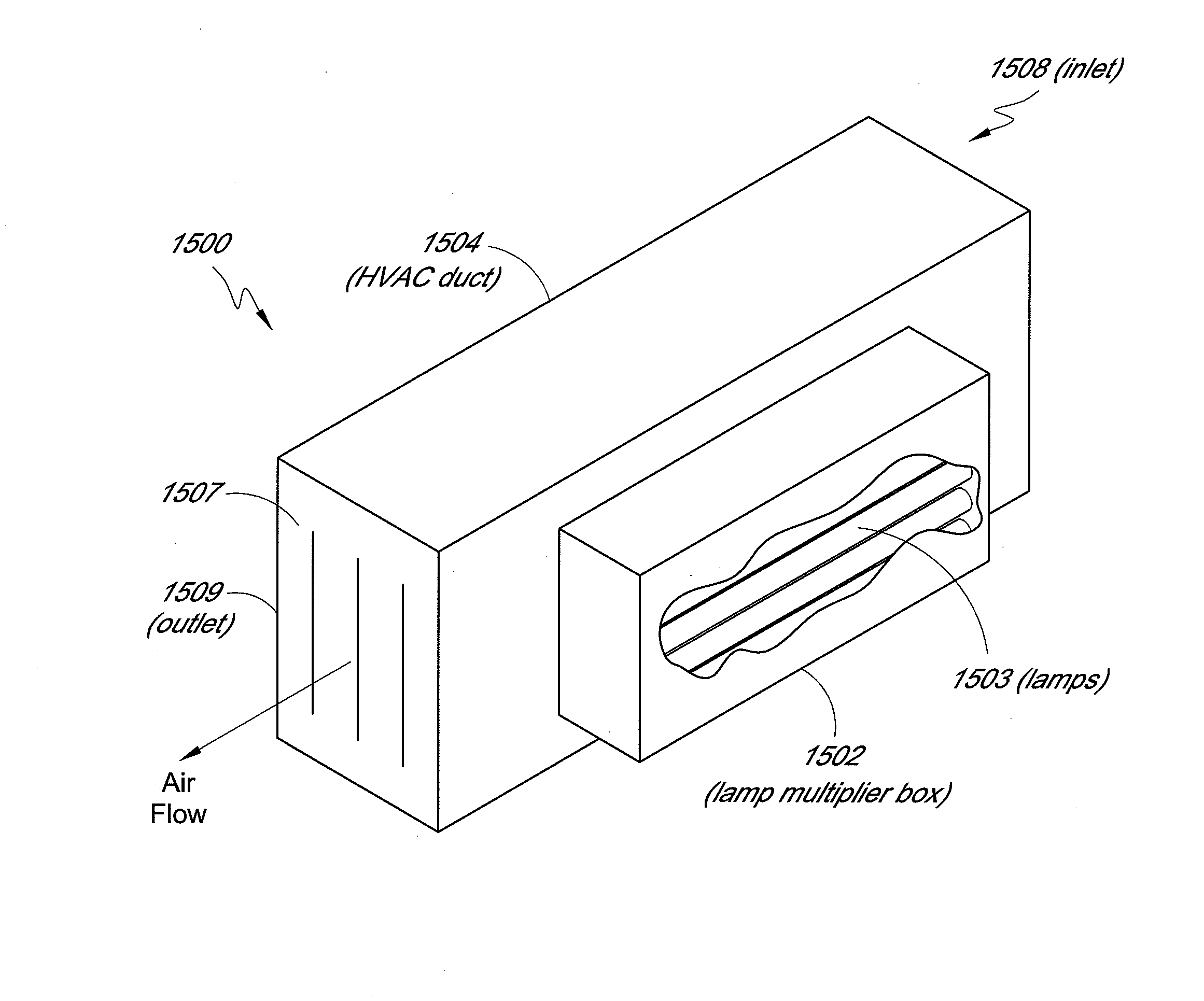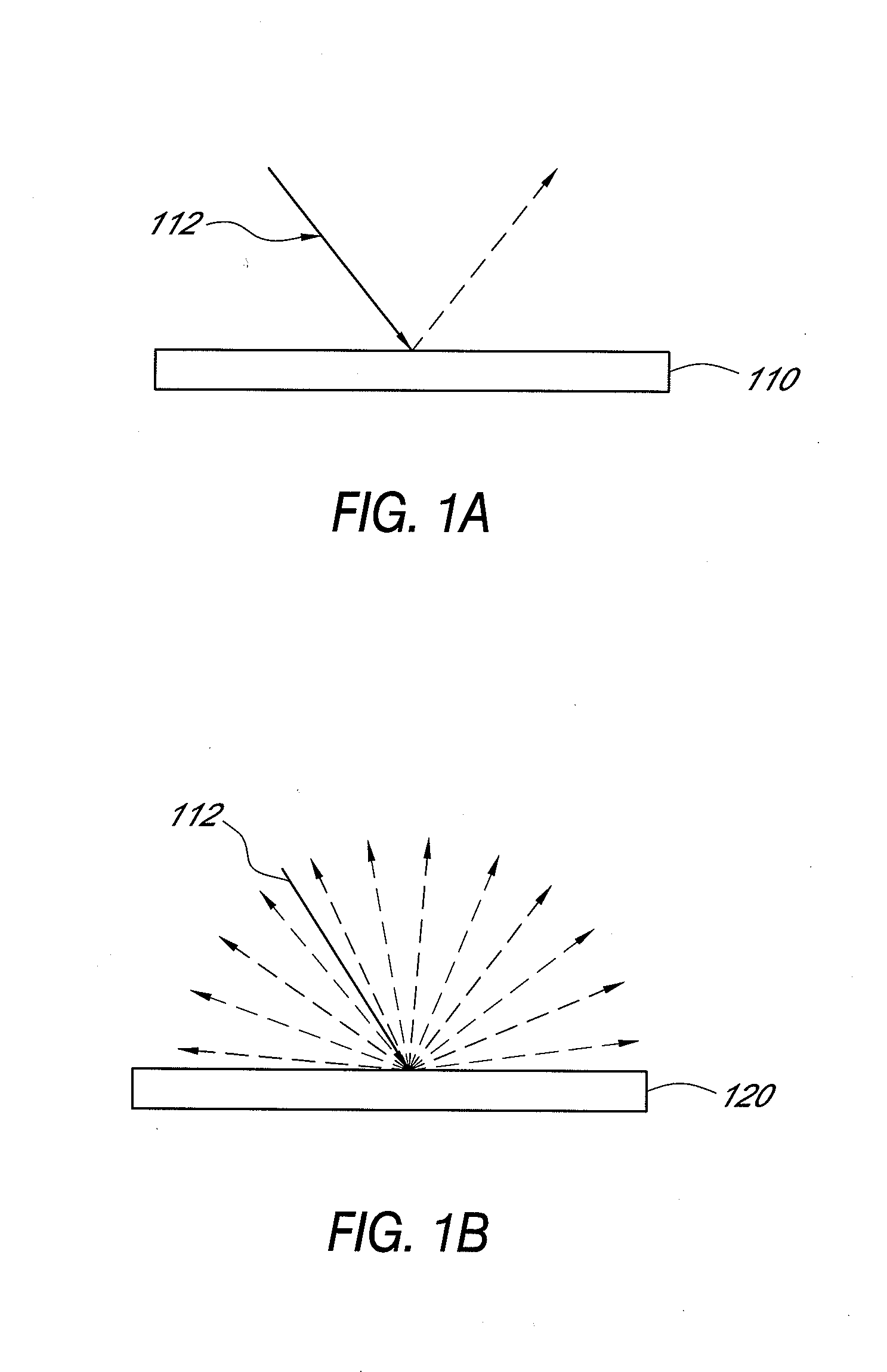UV flux multiplication system for sterilizing air, medical devices and other materials
a technology of uv flux and sterilization system, which is applied in the direction of lighting and heating apparatus, heating types, instruments, etc., can solve the problems of reducing the effectiveness of homogeneous distribution of photons within the irradiation chamber, increasing power consumption, and reducing so as to reduce the size of the air duct sterilization system, reduce the number of lamps required, and reduce the effect of power requirements
- Summary
- Abstract
- Description
- Claims
- Application Information
AI Technical Summary
Benefits of technology
Problems solved by technology
Method used
Image
Examples
example 1
Parallelepiped Sterilization Chamber with Moveable Flaps at the Inlet and Exit Ends using a Pulsed Light Source with 30% of Total Fluence Between 200-300 nm
[0077]
Air flow rate (cubic meters / second)Q = 1,141,600 cm3 / secAverage air flow velocityVave = 274.3 cm / secPeak air flow velocityvmax = 362.7 cm / secDimensions of chamberH = 50.8 cmW = 101.6 cmL = 304.8 cmTotal inner surface areaA = 103,225 cm2Area of EndsAE = 10,320 cm2Percentage of ends open to flowPOE = 2%Open area of EndsAOE = 206 cm2Number of lampsNL = 1Lamp absorbing area (per lamp)AL = 180 cm2Total lamp Area (NL × AL)ATL = 180 cm2Non-reflective area (AOE + ATL)AO = 386 cm2Ratio of non-reflecting area to totalα = 0.0037area (AO / A)ReflectivityR = 99%Fluence required for kill (99.9999%)Fkill = 0.6 Joule / cm2
[0078]Given the above parameters and performance criteria of the exemplary sterilization chamber, Equations 1 and 2 may be utilized to determine the total energy required to achieve the prescribed fluence Fkill required for t...
example 2
[0110]A complete reflecting end with dimensions 20″×40″ and approximately 2″ thick was constructed using 1 pound of quartz wool. A mesh (chicken wire, readily available from hardware supply stores) was used to contain wool fibers. An entrance plate to the chamber was removed. The exit plate was unchanged and a calorimeter placed on the entrance.
[0111]Experiment 2.1
[0112]No reflecting components were placed at the entrance opening, so the open area at the entrance was 100%. The flux was 32 mW / cm2 with a single lamp on.
[0113]Experiment 2.2
[0114]A continuous sheet of DRP reflective material 20″×28″ was placed over the entrance. The open area is therefore 30% of the total entrance area. The flux was 71 mW / cm2.
[0115]Experiment 2.3
[0116]The previously described porous reflector was placed at the entrance in place of the 20″×28″ sheet of DRP. The resulting flux was 72 mW / cm2.
[0117]These experiments 2.1 through 2.3 show that the porous reflector has the same effect on flux inside the test d...
example 3
Single Germicidal Lamp in Lamp Multiplier Box
[0128]
HVAC Duct Dimensions.Boxlength80 inchesBoxwidth20 inchesBoxheight40 inchesPercent Open Ends14%Lamp Multiplier Box DimensionsBoxlength40 inchesBoxwidth 3 inchesBoxheight40 inchesWindow Dimensions40 inches × 40 inchesLamp length40 inchesLamp Diameter1.3 inches Reflectivity0.99Absorption of lamps per pass 4%UV output64 watts, CW
[0129]For a flow rate of about 3500 cubic feet per minute, this would result in a kill of Bacillus subtilis to about 1.15 logs. The power to the lamp would be about 340 watts.
PUM
 Login to View More
Login to View More Abstract
Description
Claims
Application Information
 Login to View More
Login to View More - R&D
- Intellectual Property
- Life Sciences
- Materials
- Tech Scout
- Unparalleled Data Quality
- Higher Quality Content
- 60% Fewer Hallucinations
Browse by: Latest US Patents, China's latest patents, Technical Efficacy Thesaurus, Application Domain, Technology Topic, Popular Technical Reports.
© 2025 PatSnap. All rights reserved.Legal|Privacy policy|Modern Slavery Act Transparency Statement|Sitemap|About US| Contact US: help@patsnap.com



